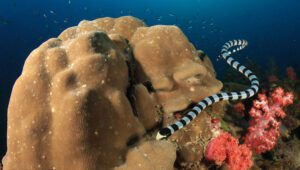Almost 70 different known species of sea snakes roam around our oceans and they usually get to be about 2 meters long. They are equipped with paddle-like tails and many have laterally compressed bodies that give them an eel-like appearance. However, unlike eels, sea snakes don’t have gills and must regularly swim to the surface to breathe. Despite their (in)famous potent venom, sea snakes are generally very mild-tempered and will not bite unless provoked. Best to watch their beauty from a safe distance!
Remarkable sea snake tidbits

Banded Sea Krait swims at coral
Genetically related to terrestrial cobras in Australia, sea snakes have evolved over time and migrated from there into the Pacific and Indian Ocean. Remarkable fact: sea snakes never got as far as the Atlantic Ocean. Although sea snakes evolved about six to eight million years ago in the Coral Triangle of Southeast Asia, the majority of the species only appeared one to three million years ago. So, by the time any of them could have spread across the Pacific, the Isthmus of Panama, the narrow strip that links North and South America, had closed. This pretty much blocked the access to the Atlantic Ocean for the snakes. Moreover, sea snakes require fresh water which makes it unlikely that they would reach the Atlantic via South Africa: the ocean is too cold and it is also too dry on land to be using that route. Lastly, scientists claim the Red Sea is too salty for sea snakes.
Banded sea kraits
Within the sea snake family, the sea kraits form a separate section. Sea kraits are more primitive and are semiaquatic. This means that they spend limited time on land. Other sea snake species live purely in water for most or all their life. Kraits go on land to lay eggs, whereas other sea snakes give birth to live young underwater. Most sea snakes species are able to breathe through the top of their skin. This is unusual for reptiles, as their skin is normally thick and scaly. Scientific experiments have demonstrated that by doing so, sea snakes can generate about 25% of their required oxygen, which allows for longer dives. Combined with their extraordinary big lungs, they can remain underwater for as long as two hours and dive down as deep as 90 meters. Here in Thailand we often see sea snakes and in particular the banded sea krait during our dives; both on the Similan and our Southern Phuket itineraries. Come and dive with The Junk Liveaboards to see sea snakes and kraits during our dives all year round. Take a look at these interesting creatures:

